Culture of Palestine
| Part of a series on |
| Palestinians |
|---|
 |
| Demographics |
| Politics |
|
| Religion / religious sites |
| Culture |
| List of Palestinians |
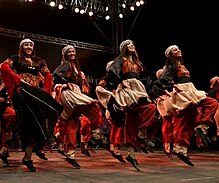
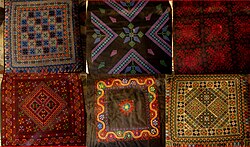

The culture of Palestinians is influenced by the many diverse cultures and religions which have existed in the historical region of Palestine and the state of Palestine. The cultural and linguistic heritage of Palestinian Arabs along with Lebanese, Syrians, and Jordanians is integral part of Levantine Arab culture.[1] Palestinians also have their own dialect of Arabic, the Palestinian dialect.
Cultural contributions to the fields of art, literature, music, costume and cuisine express the Palestinian identity despite the geographical separation between the Palestinians from the Palestinian territories, Palestinian citizens of Israel and Palestinians in the diaspora.[2][3]
Palestinian culture consists of food, dance, legends, oral history, proverbs, jokes, popular beliefs, customs, and comprising the traditions (including oral traditions) of Palestinian culture. The folklorist revival among Palestinian intellectuals such as Nimr Sirhan, Musa Allush, Salim Mubayyid, and others emphasized pre-Islamic cultural roots.
Palestine's significant intangible cultural heritage has been recognised by UNSECO, with a first inscription for Palestinian hikaye made in 2008 to its list of intangible cultural heritage.[4] This was followed by a further listing in 2021 for Palestinian embroidery,[5] and joint listings with other Arab States for calligraphy and knowledge and use of the date palm.[6][7]
Traditional wear
[edit]
Foreign travelers to Palestine in the late 19th and early 20th centuries often commented on the rich variety of traditional clothing among the Palestinian people, and particularly among the fellaheen or village women. Until the 1940s, a woman's economic status, whether married or single, and the town or area they were from could be deciphered by most Palestinian women by the type of cloth, colors, cut, and embroidery motifs, or lack thereof, used for the robe-like dress or "thoub" in Arabic.[8]
The 1948 Palestinian expulsion and flight led to a disruption in traditional modes of dress and customs, as many women who had been displaced could no longer afford the time or money to invest in complex embroidered garments.[9] New styles began to appear the 1960s. For example, the "six-branched dress" named after the six wide bands of embroidery running down from the waist.[10] These styles came from the refugee camps, particularly after 1967. Individual village styles were lost and replaced by an identifiable "Palestinian" style.[11] The shawal, a style popular in the West Bank and Jordan before the First Intifada, probably evolved from one of the many welfare embroidery projects in the refugee camps. It was a shorter and narrower fashion, with a western cut.[12] The keffiyeh, also known as "hattah", is a traditional black and white headdress worn by Palestinian farmers. Since the Arab Revolt of the 1930s, it has become a prominent symbol of Palestinian resistance in the Israeli Palestinian conflict.
In 2021 Palestinian embroidery was inscribed to UNESCO's list of intangible cultural heritage.[5]
Dance
[edit]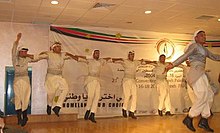
Dabke (Arabic: دبكة), is a folk dance that originates from the Levant.[13] It is popular in Palestinian culture and many other cultures in the Levant, and many troupes perform the dance throughout the world. The Dabke is marked by synchronized jumping, stamping, and movement, similar to tap dancing.[14][15][16][17][18]
Folk tales
[edit]Traditional storytelling among Palestinians is prefaced with an invitation to the listeners to give blessings to God and the Prophet Mohammed or the Virgin Mary as the case may be, and includes the traditional opening: "There was, in the oldness of time ..." Formulaic elements of the stories share much in common with the wider Arab world, though the rhyming scheme is distinct. There are a cast of supernatural characters: Jinss and Djinns who can cross the Seven Seas in an instant, giants, and ghouls with eyes of ember and teeth of brass.[citation needed]
Palestinian folk tales often include stories and anecdotes about Saint George, the patron saint of Palestine. For instance, one story from the village of Ein Karem includes a visit from Saint George during a drought.[19] Often times, folk tales of Saint George are a source of endurance and hope for Palestinians, both Muslim and Christian.
Palestinian hikaye is a form of women's oral literature that addresses social questions. Performed in winter, older women address the stories to younger women and children.[20][21] In 2008 it was inscribed to UNESCO's list of intangible cultural heritage.[22]
Music
[edit]
Traditional Palestinian songs have no set lyrics but rather a set rhythm to them, allowing for improvised folk poetry lyrics. A form of this style of folk singing is Ataaba; it consists of 4 verses, following a specific form and meter. The distinguishing feature of ataaba is that the first three verses end with the same word meaning three different things, and the fourth verse serves as a conclusion. The Ataaba continues to be performed at weddings and festivals in Arab localities in Israel, the West Bank and Gaza strip.[24]
Other traditional Palestinian song styles include zajal, Bein Al-dawai, Al-Rozana, Zarif – Al-Toul, Al-Maijana, Sahja/Saamir and Zaghareed.
Over three decades, the Palestinian National Music and Dance Troupe (El Funoun) and Mohsen Subhi have reinterpreted and rearranged traditional wedding songs such as Mish'al (1986), Marj Ibn 'Amer (1989) and Zaghareed (1997).[25]
Theater
[edit]Palestinian theater resembles other Arab theaters, but differs significantly because of the history of the area and its people. It came about with difficulty and was initially focused inward, but has since grown into a distinct cultural practice. Marie Elias, in the Interactive Encyclopedia of the Palestine Question, recognizes three different stages. Palestinian theater started in the "context of a cultural renaissance" across the Levant and particularly in the 1920s, with productions based on Arab texts or translated European plays. A second period a "rebirth" occurred in the late 1960s, and after the Six-Day War of 1967 "a clear, but uncoordinated, desire was expressed, both within Palestine and abroad, to develop theater with a Palestinian identity", according to Elias. A notable group from that period is the Balalin Theater Troupe, which had started in 1970 as the Theater Family troupe. A third period started in 1993, after the Oslo Agreement, which saw a professionalization in the West Bank, though developments in the Gaza Strip were much more difficult.[26]
Architecture
[edit]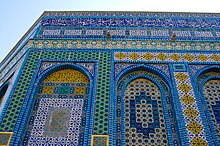
Traditional Palestinian architecture covers a vast historical time frame and a number of different styles and influences over the ages. The urban architecture of Palestine prior to 1850 was relatively sophisticated. While it belonged to greater geographical and cultural context of the Levant and the Arab world, it constituted a distinct tradition, "significantly different from the traditions of Syria, Lebanon or Egypt." Nonetheless, the Palestinian townhouse shared in the same basic conceptions regarding the arrangement of living space and apartment types commonly seen throughout the Eastern Mediterranean. The rich diversity and underlying unity of the architectural culture of this wider region stretching from the Balkans to North Africa was a function of the exchange fostered by the caravans of the trade routes, and the extension of Ottoman rule over most of this area, beginning in the early 16th century through until the end of World War I.[27][28][29]
Sports
[edit]Palestinian athletes have competed at every Olympic Games since the 1996 Summer Olympics. The Palestinian Olympic committee did not work with the Israeli Olympic committee to train for the 2012 Olympic games,[30] and participation in the 2013 Mediterranean Games.[31]
Games inherited from the Ottoman era were the starting point of Palestinian sports during the British Mandate. These games included horse racing, running, wrestling and swimming. However, football gained popularity over time.
The true beginning of the phenomenon of establishing social-athletic clubs in Palestine can be traced to the early twentieth century, specifically the 1920s. Since that time, sports – especially football – had become a social tradition; a pivotal part of Palestinian culture. Many of these clubs were established as social-cultural clubs.[citation needed]
Only a few clubs were established solely as athletic, while the majority emerged as social and later adopted athletic activities. By 1948, there were some 65 athletic clubs in Palestine; approximately 55 of them were members of the Arab Palestine Sports Federation (APSF) which was established in 1931 and re-established in 1944. These clubs had a tremendous impact on the lives of Palestinian young people, shaping their character and preparing them for social and political involvement.[citation needed]
There is a West Bank Premier League, and Gaza Strip League. The Palestine national football team played Afghanistan in the 2014 FIFA World Cup qualifiers. They visited Australia for the 2015 AFC Asian Cup.
The Beit Jala Lions is a West Bank Rugby Union team.
The Turmus Aya Equestrian Club, established in 2007, is a riding club dedicated to the mission of providing affordable access to horses for Palestinians. Ashraf Rabi, the founder, maintains that "this is part of the development of Palestine. Horses are a big part of our Arab culture and we must embrace it."[32]
Palestinian art
[edit]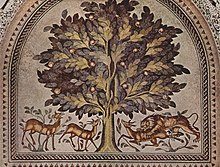
Similar to the structure of Palestinian society, the Palestinian field of arts extends over three main geographic centers:[33]
- the West Bank and Gaza Strip
- the Palestinian diaspora in the Arab world
- Europe, the United States and elsewhere.
Contemporary Palestinian art finds its roots in folk art and traditional Christian and Islamic painting. After the 1948 Palestinian expulsion and flight, nationalistic themes have predominated as Palestinian artists use diverse media to express and explore their connection to identity and land.[34] In the 1990s Salam Dyab, Hisham Zreiq, Issa Dibe and others began to adopt modern styles and symbolism.
Modern cuisine
[edit]
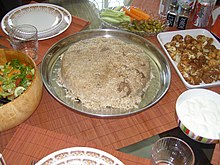
Palestine's history of rule by many different empires is reflected in Palestinian cuisine, which has benefited from various cultural contributions and exchanges. Generally speaking, modern Palestinian dishes have been influenced by the rule of three major Islamic groups: the Arabs, the Persian-influenced Arabs, and the Turks.[35] The original Bedouin Arabs in Syria and Palestine had simple culinary traditions primarily based on the use of rice, lamb and yogurt, as well as dates.[36]
The cuisine of the Ottoman Empire, which incorporated Palestine as one of its provinces between 1517 and 1918, was partially made up of what had become by then a rich Arab cuisine. After the Crimean War, many foreign communities (namely the Bosnians, Greeks, French and Italians) began settling in the area; Jerusalem, Jaffa and Bethlehem were the most popular destinations for these groups. The cuisine of these communities, particularly those of the Balkans, contributed to the character of Palestinian cuisine.[35][37] Nonetheless, until the 1950s and 1960s, the staple diet for many rural Palestinian families revolved around olive oil, oregano (za'atar) and bread, baked in a simple oven called a taboon.[38]
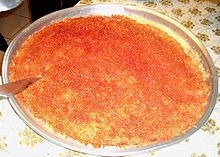
Palestinian cuisine is divided into three regional groups: the Galilee, West Bank and Gaza area. Cuisine in the Galilee region shares much in common with Lebanese cuisine, due to extensive communication between the two regions before the establishment of Israel. Galilee inhabitants specialize in producing a number of meals based on the combination of bulgur, spices and meat, known as kibbee by Arabs. Kibbee has several variations including it being served raw, fried or baked.[37][39] Musakhan is a common main dish that originated in the Jenin and Tulkarm areas of the northern West Bank. It consists of a roasted chicken over a taboon bread that has been topped with pieces of fried sweet onions, sumac, allspice and pine nuts, cooked and finished with a generous helping of olive oil.[39] Other meals common to the area are maqluba and mansaf, the latter originating from the Bedouin population of Jordan.
The cuisine of the Gaza Strip is influenced both by neighboring Egypt and its location on the Mediterranean coast. The staple food for the majority of the inhabitants in the area is fish. Gaza has a major fishing industry and fish is often served either grilled or fried after being stuffed with cilantro, garlic, red peppers, cumin, and then marinated in a mix of coriander, red peppers, cumin, and chopped lemons.[40][41] The Egyptian culinary influence is also seen by the frequent use of hot peppers, garlic and chard to flavor many of Gaza's meals.[39] A dish native to the Gaza area is Sumaghiyyeh, which consists of water-soaked ground sumac mixed with tahina, which is then added to sliced chard, pieces of stewed beef, and garbanzo beans.[40]
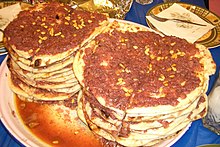
There are several foods native to Palestine that are well known in the Arab world, such as, Kinafe Nabulsi, Nabulsi cheese (cheese of Nablus), Ackawi cheese (cheese of Acre), Rumaniyya (from Jaffa), Sumaghiyyeh (a stew from Gaza) and Musakhan. Kinafe originated in Nablus, as well as the sweetened Nabulsi cheese used to fill it. Baqlawa, a pastry introduced at the time of the Ottoman Sultan Suleiman the Magnificent, is also an integral part of Palestinian cuisine.[citation needed]
Chick-pea based falafel, which substituted for the fava beans used in the original Egyptian recipe, and added Indian peppers, introduced after the Mongol invasions opened new trade routes, are a favorite staple in Mediterranean cuisine.[42]
Entrées that are eaten throughout the Palestinian Territories include waraq al-'inib, boiled grape leaves wrapped around cooked rice and ground lamb. Mahashi is an assortment of stuffed vegetables such as zucchinis, potatoes, cabbage and, in Gaza, chard.
Film
[edit]
Palestinian cinema is relatively young compared to Arab cinema overall and many Palestinian movies are made with European and Israeli support.[44] Palestinian films are not exclusively produced in Arabic; some are made in English, French or Hebrew.[45] More than 800 films have been produced about Palestinians, the Israeli–Palestinian conflict, and other related topics; notable examples are Divine Intervention and Paradise Now.
Handicrafts
[edit]A wide variety of handicrafts, many of which have been produced by Palestinians for hundreds of years, continue to be produced today. Palestinian handicrafts include embroidery and weaving, pottery-making, soap-making, glass-making, and olive wood and Mother of Pearl carvings.[citation needed]
In 2021 and 2022 respectively, joint nominations made by Palestine and other Arab States were inscribed to UNESCO's list of intangible cultural heritage for the knowledge and use of the date palm, and Arabic calligraphy.[6][7]
Intellectuals
[edit]In the late 19th century and early 20th century, Palestinian intellectuals were integral parts of wider Arab intellectual circles, as represented by individuals such as May Ziadeh and Khalil Beidas. Educational levels among Palestinians have traditionally been high. In the 1960s, the West Bank had a higher percentage of its adolescent (15 to 17 years of age) population enrolled in high school than Israel; the West Bank had a 44.6% high school enrollment rate versus a 22.8% enrollment rate in Israel.[46] Claude Cheysson, France's Minister for Foreign Affairs under the first Mitterrand Presidency, held in the mid eighties that "even thirty years ago, [Palestinians] probably already had the largest educated elite of all the Arab peoples."[47]
Diaspora figures like Edward Said and Ghada Karmi, Arab citizens of Israel like Emile Habibi, and Jordanians like Ibrahim Nasrallah have made contributions to a wide number of fields, exemplifying the diversity of experience and thought among Palestinians.[48]
Literature
[edit]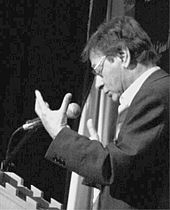
The long history of the Arabic language and its rich written and oral tradition form part of the Palestinian literary tradition as it has developed over the course of the 20th and 21st centuries.
Since 1967, most critics have theorized the existence of three "branches" of Palestinian literature, loosely divided by geographic location: 1) from inside Israel, 2) from the occupied territories, 3) from among the Palestinian diaspora throughout the Middle East.[49]
Modern poetry
[edit]Poetry, using classical pre-Islamic forms, remains an extremely popular art form, often attracting Palestinian audiences in the thousands. Until 20 years ago, local folk bards reciting traditional verses were a feature of every Palestinian town.[50] After the 1948 Palestinian exodus, poetry was transformed into a vehicle for political activism. From among those Palestinians who became Arab citizens of Israel after the passage of the Citizenship Law in 1952, a school of resistance poetry was born that included poets like Mahmoud Darwish, Samih al-Qasim, and Tawfiq Zayyad.[50] The work of these poets was largely unknown to the wider Arab world for years because of the lack of diplomatic relations between Israel and Arab governments. This changed after Ghassan Kanafani, another Palestinian writer in exile in Lebanon, published an anthology of their work in 1966.[50] Palestinian poets often write about a sense of loss and existence in the diaspora.[50]
Modern music
[edit]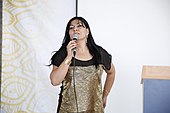
Palestinian music is well known throughout the Arab world.[51] It reflects the Palestinian experience, primarily dealing with the struggle with Israel.[52] A new wave of performers emerged with distinctively Palestinian themes following the 1948 Palestinian expulsion and flight, relating to the dreams of statehood and the burgeoning nationalist sentiments.
Since the 1990s the subgenre of Palestinian hip hop has blended the traditional folk music elements of Palestinian music and Arabic melodies with hip hop beats. These artists see themselves as joining a “longer tradition of revolutionary, underground, Arabic music and political songs that have supported Palestinian Resistance”,[53] "[tailoring] the style to express their own grievances with the social and political climate in which they live and work".[54]
Modern Palestinian singers include Mohammed Assaf, Yacoub Shaheen, Toni Qattan, and Elyanna.
See also
[edit]References
[edit]- ^ Albala, Ken (25 May 2011). Food Cultures of the World Encyclopedia [4 volumes]: [4 volumes]. Bloomsbury Publishing USA. ISBN 978-0-313-37627-6.
- ^ Ismail Elmokadem (10 December 2005). "Book records Palestinian art history". Archived from the original on 19 April 2007. Retrieved 18 April 2008.
- ^ Danny Moran. "Manchester Festival of Palestinian Literature". Manchester Festival of Palestinian literature. Archived from the original on 31 March 2008. Retrieved 18 April 2008.
- ^ Adam, Thomas; Stiefel, Barry L.; Peleg, Shelley-Anne (17 April 2023). Yearbook of Transnational History: (2023). Rowman & Littlefield. pp. 17–18. ISBN 978-1-68393-379-3.
- ^ a b "UNESCO - The art of embroidery in Palestine, practices, skills, knowledge and rituals". ich.unesco.org. Retrieved 10 November 2023.
- ^ a b "Calligraphy". Encyclopedia of Arabic Language and Linguistics. doi:10.1163/1570-6699_eall_eall_dum_0028. Retrieved 10 November 2023.
- ^ a b "UNESCO - Date palm, knowledge, skills, traditions and practices". ich.unesco.org. Retrieved 10 November 2023.
- ^ Jane Waldron Grutz (January–February 1991). "Woven Legacy, Woven Language". Saudi Aramco World. Archived from the original on 19 February 2007. Retrieved 4 June 2007.
- ^ Saca, Iman (2006). Embroidering Identities: A Century of Palestinian Clothing. The Oriental Institute Museum of the University of Chicago. ISBN 1-885923-49-X.
- ^ Weir, Shelagh (1989) Palestinian Costume. British Museum. ISBN 0-7141-1597-5. p. 112.
- ^ Skinner, Margarita (2007) Palestinian Embroidery Motives. A Treasury of Stitches 1850-1950. Melisende. ISBN 978-1-901764-47-5. p. 21.
- ^ Weir, Shelagh (1989) Palestinian Costume. British Museum. ISBN 0-7141-1597-5. pp. 88, 113.
- ^ FANN, BAYT AL (25 July 2022). "The Art of Dabke". Bayt Al Fann. Retrieved 26 December 2024.
- ^ "The Dabke-An Arabic Folk Dance". History and Development of Dance/ Brockport. 9 May 2013. Archived from the original on 26 August 2017. Retrieved 5 June 2017.
- ^ "What is Dabke exactly?". Dabketna.com. 5 December 2012. Archived from the original on 7 January 2017. Retrieved 7 January 2017.
- ^ "Dancing the Dabke". Archaeoadventures: Women-Powered Travel. 22 April 2012. Archived from the original on 25 August 2017. Retrieved 7 January 2017.
- ^ "Event: Dabke Dance Workshop – Vassar BDS". vsa.vassar.edu. Archived from the original on 7 January 2017. Retrieved 7 January 2017.
- ^ "Dabke". Canadian Palestinian Association in Manitoba. Archived from the original on 12 June 2018. Retrieved 7 January 2017.
- ^ "Palestinian Folktale and lore: Saint George/Elijah/El Khadr". Sonia Sulaiman. 13 July 2023. Retrieved 26 December 2024.
- ^ "Żeby nie zapomnieć | Tygodnik Powszechny". www.tygodnikpowszechny.pl (in Polish). 30 November 2020. Retrieved 22 November 2023.
- ^ Rivoal, Isabelle (1 January 2001). "Susan Slyomovics, The Object of Memory. Arabs and Jews Narrate the Palestinian Village". L'Homme. Revue française d'anthropologie (in French) (158–159): 478–479. doi:10.4000/lhomme.6701. ISSN 0439-4216.
- ^ Adam, Thomas; Stiefel, Barry L.; Peleg, Shelley-Anne (17 April 2023). Yearbook of Transnational History: (2023). Rowman & Littlefield. pp. 17–18. ISBN 978-1-68393-379-3.
- ^ William McClure Thomson, (1860): The Land and the Book: Or, Biblical Illustrations Drawn from the Manners and Customs, the Scenes and Scenery, of the Holy Land Archived 2016-06-29 at the Wayback Machine Vol II, p. 578.
- ^ Shiloah, Amnon (1997), The Performance of Jewish and Arab Music in palestine Today: A Special Issue of the Journal Musical Performance, Taylor & Francis, ISBN 978-90-5702064-3
- ^ "El-Funoun Palestinian Popular Dance Troupe". Archived from the original on 5 January 2009. Retrieved 24 August 2009.
- ^ Elias, Marie. "Palestinian Theater: The Bumpy History of a Maturing Art". Interactive Encyclopedia of the Palestine Question. Retrieved 4 December 2023.
- ^ Ron Fuchs in Necipoğlu, 1998, p. 173.
- ^ Hadid, Mouhannad (2002). Architectural styles survey in Palestinian territories (PDF). Palestinian National Authority Ministry of Local Government. Archived (PDF) from the original on 9 August 2017. Retrieved 1 December 2016.
- ^ Petersen, Andrew (11 March 2002). Dictionary of Islamic Architecture. Routledge. ISBN 978-0-203-20387-3. Archived from the original on 8 June 2013. Retrieved 16 March 2013.
- ^ "Israel, Palestine hold 'Sports for Peace' talks". 20 April 2011. Archived from the original on 26 April 2011. Retrieved 26 July 2011.
- ^ "Olympics Features: Rome hosts Israel and Palestine to promote peace through sport". Archived from the original on 12 September 2011. Retrieved 26 July 2011.
- ^ "Equestrian club caters to all". Archived from the original on 1 February 2019. Retrieved 26 July 2011.
- ^ Tal Ben Zvi (2006). "Hagar: Contemporary Palestinian Art" (PDF). Hagar Association. Archived (PDF) from the original on 4 October 2018. Retrieved 5 June 2007.
- ^ Ankori, 1996.
- ^ a b Revisiting our table... Archived 2013-11-27 at the Wayback Machine Nasser, Christiane Dabdoub, This week in Palestine, Turbo Computers & Software Co. Ltd. June 2006. Retrieved 2008-01-08.
- ^ ABC of Arabic Cuisine Archived 2011-07-04 at the Wayback Machine ArabNet. Retrieved 2007-12-25.
- ^ a b An Introduction to Palestinian Cuisine: Typical Palestinian Dishes Archived 2011-07-24 at the Wayback Machine This Week in Palestine, Turbo Computers & Software Co. Ltd. July 2001. Retrieved 2007-01-07.
- ^ Modernity and Authenticity: The Evolution of the Palestinian Kitchen Archived 2011-07-24 at the Wayback Machine Qleibo, Ali, This week in Palestine, Turbo Computers & Software Co. Ltd. December 2006. Retrieved 2008-01-09.
- ^ a b c "How many countries recognize Palestine as a state?". Institute for Middle East Understanding. 2006–2007. Archived from the original on 11 October 2007. Retrieved 27 February 2008.
- ^ a b The Foods of Gaza Archived 2011-07-24 at the Wayback Machine al-Haddad, Laila, This week in Palestine. Turbo Computers & Software Co. Ltd. June 2006. Retrieved 2008-01-07.
- ^ The rich flavors of Palestine Archived 2009-04-16 at the Wayback Machine Farsakh, Mai M. Institute for Middle East Understanding (IMEU), (Originally published by This Week in Palestine Archived 2017-06-26 at the Wayback Machine) 2006-06-21. Retrieved 2007-12-18.
- ^ VJJE Publishing Co. "Jodi Kantor, 'A History of the Mideast in the Humble Chickpea.'". E-cookbooks.net. Archived from the original on 3 March 2016. Retrieved 22 April 2009.
- ^ List of Irgun attacks
- ^ "Xan Brooks on Palestinian directors". The Guardian. London. 12 April 2006. Archived from the original on 24 July 2008. Retrieved 22 April 2009.
- ^ "Palestine Film Foundation". www.palestinefilm.org. Archived from the original on 12 June 2008.
- ^ See Elias H.Tuma, Haim Darin-Drabkin, The Economic case for Palestine, Croom Helm, London, 1978 p.48.
- ^ Interview with Elias Sanbar. Claude Cheysson, ‘The Right to Self-Determination,’ Journal of Palestine Studies Vol.16, no.1 (Autumn 1986) pp.3-12 p.3
- ^ "Biography Ibrahim Nasrallah". Pontas literary & film agency. Archived from the original on 26 May 2010. Retrieved 14 December 2010.
- ^ Steven Salaita (1 June 2003). "Scattered like seeds: Palestinian prose goes global". Studies in the Humanities. Archived from the original on 13 June 2008. Retrieved 6 September 2007.
- ^ a b c d Shahin, 2005, p. 41.
- ^ Poché, Christian. "Palestinian music". Grove Dictionary of Music and Musicians. Retrieved 10 March 2008.[dead link]
- ^ Regev Motti (1993), Oud and Guitar: The Musical Culture of the Arabs in Israel (Institute for Israeli Arab Studies, Beit Berl), ISBN 965-454-002-9, p. 4.
- ^ Maira, Sunaina (2008). "We Ain't Missing: Palestinian Hip Hop - A Transnational Youth Movement". CR: The New Centennial Review. 8 (2): 161–192. doi:10.1353/ncr.0.0027. S2CID 144998198.
- ^ Amelia Thomas (21 July 2005). "Israeli-Arab rap: an outlet for youth protest". Christian Science Monitor. Archived from the original on 10 August 2017. Retrieved 5 June 2017.
